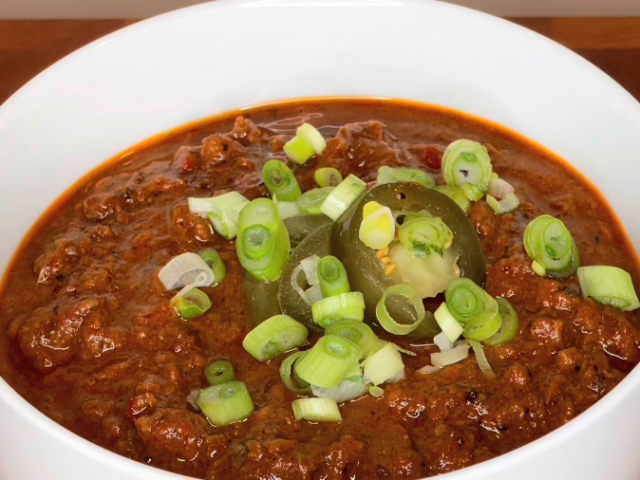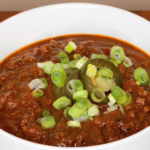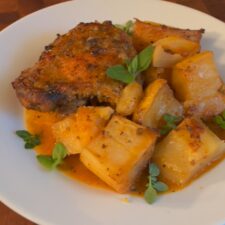
Chili is the quintessential American meal. As much of controversial this statement is, I do think that Chili con Carne is the most American of all meals. It Was born in the wide open fields of Texas at the back of chuck wagons to feed and nourish hungry cowboys. It is the blending and slow simmer together of different cultures that did meet under difficult conditions and great to become something special.
Hugh Fearnley-Whittingstall Pantone’s in his book The River Cottage Meat Book describes chili as “it is really an American bastardization of at least two Mexican dishes the Mole and the Picadillo.” Of course then he proceeds to make his own version that contains Chorizo, Pork, and Beef. Something that will make every Texan, and every Cincinnatian as matter of fact, to frown the least. Truth be told it does share a lot with both Mole and Picadillo. It is a dish that is heavily seasoned with dried and occasionally fresh chilies, is made mainly of beef, and… that’s it. It was born out of necessity and adaptation. A chuck wagon had little space on it. It will have things that can keep for long time, like dried beans and chilies, and occasionally some meat.
I am sure you think now, how the heck would meat last outside a refrigerator in the heat of the chuck wagon? It doesn’t! But back then the concept of refrigeration was not even in the picture. All households will have some sort of meat hanging from a meat hook and try to finish it within a couple of days. Of course you can finish a whole cow in two days, unless you have a family of, I don’t know, 50 to feed. But there are ways to preserve the meat. And the colonizers learned from the natives, and they start using chilies, salt and spices in an effort to make the meat last longer. This is what the Cowboys will do as well. Those were the chili bricks. Dried beef that was dried and pounded together with fat, chilies, and spices. When you reconstitute it you can have the basic chili. Once you make the chili you can keep heating it and it will only get better.
As you can imagine very often it won’t be enough so at some point and genius cook added the beans to stretch it and make it last longer. Occasionally the cowboys will catch a small goat or other game that will also become chili. Bob Walsh in his book “The chili Cookbook” talks about the Longhorn chili made of the meat of the longhorn cow that was touch and almost inedible. It was used for mainly for hides and the beef fat called tallow that was used for candle making and soap. Chili is a great way to utilize this cut of meat. Cooking for long time will eventually break the meat down and make it more palatable. A great example of the usage of chili.
In reality we don’t know where chili originated. The ingredients are in deed Mexican, oregano, chilies, and cumin. But it is most certainly born and made in Texas. Other than that we don’t know much. We can trace its history back to the Aztecs that made stews with meat, chilies and other seasonings. But if you think of it, it is the only way to season and cook meat in a camp fire back then was with chilies. Some of the meat might already start getting rotten so adding the chilies might cover the smell. So here is the picture, you have hungry men, that have some sort of questionable meat, and just some dried chilies salt and pepper. It doesn’t take too long to put 2 and 2 together.
There is also this urban legend, that 15 families that came from the Canary Islands brought chili with them. In the wonderful book of Bob Walsh we read that In reality 15 families came from Canary Islands, and they did bring with them a lot of techniques that are relying on the heavy use of cumin and other spices in stews something that is reminiscent of cooking in tagines. They definitely influence the recipes of chili and although cumin was already part of the cuisine it was not used with such a heavy hand. Bringing their experience and flavors did influence to some extent the chili as we know it today, but by no means they invented it. But it is part of the American culture where different culinary influence are blended together and create an amalgam of flavors and aromas.
There are no written records of when the first chili that was made or where was it made, but we start seeing mentions of chili that resembles the modern version of chili, around 1850. The “chili revolution” happened in the turn of the century where the chili powder became a commercial product. Convenient and easy chili became even easier to make. By this time the area around San Antonio had pop-up chili stands where you can just buy a bowl of chili. Now chili has become stable not only of Texas but the entire United States. They often it is associated with Super Bowl, hotdogs, and tacos. In reality though those are not traditional Chili’s they’re more ground beef that has been converted to some sort of pasta sauce and shares the same flavor profile with the actual chili. Cincinnati is famous for its chili which is exactly that! And the legend has it not started based on the Greek recipe for meat sauce.
When it comes to the absolute chili recipe unfortunately there isn’t one. The only two ingredients that you definitely must have in Chili are chiles and time. You can add meat or just vegetables, you can add beans, tomatoes, and anything you feel pleases your tastebuds, and it is going to be still a chili, as long as you cook it slow and low with chilies. In this recipe however, I want to stick, to the original Texan chili or at least how I imagine it to be. I’m trying to make it closer to what I would imagine the Cowboys will had back then, minus the rotten meat.
The most important parts are the chiles. In the true Texan chili you don’t have tomatoes so all the color and flavor has to come from the chilies. My favorite Chili’s as a base are Anchos, Guajilla, Mulato, Pasilla, New Mexico, and Cascabel. They are rich and deep in flavor and low in heat. You can essentially add as many as you want without making the chili inedible from the spiciness. Then we have the chipotle for a deep smoky flavor and a good dose of heat. Fro more heat I like Puya, arbol, and cayenne. I also recently discovered chiltepin and pequin tiny but so pungent and hot. I try by weight to go 80% of the mild chilies and a mix to my liking of the other chilies. Don’t make it too hot. It is not a hot sauce, it is still supposed be eatable. I also recently started adding some fresh chillies that give a fresher and fruitier taste.
The other important ingredient is the meat. Although you can use any meat you like, I think that using beef cuts like chuck or even round steak are perfect for the long cooking of chili. Purists will disagree but you can also use pork lamb and any other meat that benefits from long cooking. Although certain chilis like the one from Cincinnati do use ground beef, I find that it is too crumbly and dries too much before the flavors mellow (yes meat can dry in moist environment, but that’s another post). So I prefer to have either manually cut the meat to 1/2 inch cubes or thinly slice it like the one on the video. But if you like ground beef, that’s fine too.
Which brings us to the cooking method. It has to be slow and low and has to allow for some evaporation of the liquid to concentrate flavors. That means you cannot use pressure cooker and you cannot use sous vide. A heavy pot like a Dutch oven is the best option for this. Cast iron even better. You need something to adsorb the heat and slowly release it to the stew (because that’s what it is). So now that we saw the principles of chili, it is time to make it. Browning some of the meat is essential to build that fond at the bottom of the pot.
Watch the video:

Chili Con Carne
-
 Prep Time: 1 hour
Prep Time: 1 hour -
 Cook Time: 4 hours
Cook Time: 4 hours -
 Total Time: 5 hours
Total Time: 5 hours -
 Yield: 10
Yield: 10 -
 Category: America
Category: America -
 Method: Stewing
Method: Stewing -
 Cuisine: American
Cuisine: American
Description
Chili, the quint essential American meal. Born in the back of a chuck wagon as nourishment for hungry cowboys after a long day of herding cattle. Heart warming, filling, tasty, and easy to make.
Ingredients
Chile paste
- 2 Ancho chilies
- 2 Mulato chilies
- 3 Guajillas chilies
- 2 Chipotle
- 8 Chiltepin
- 1 tbsp whole cumin
- 6 tbsp masa harina or 6 corn tortillas
- 1-2 cups of water
Chili
- 4 lbs of meat of your choice cut in 1/2 inch cubes
- 6 tbsp olive oil
- 2 medium onion
- 2 medium Chile peppers (fresno and jalapeño)
- 2 tbsp tomato paste
- 1 cup of the chiles paste
- Enough water or beef broth to cover everything (4 cups or so)
- Optional: 1 lbs of dried and soaked beans overnight
Instructions
- Roast the dried chilies in a pan until it just starts to smoke.
- Add 1-2 cups of water until they are barely covered.
- Let them steep for 30 mins.
- Transfer them to the blender chilies and liquid and blend on high until smooth
- Jar and save for later use.
- Add some olive oil in the dutch oven.
- Brown the meat in portions to build some fond (1/3 is enough but you can do the whole thing if you like).
- Once all the meat is done, add some more olive oil and add the onions and the fresh chili.
- Once it is translucent add the tomato paste and the chili paste.
- Cook until fragrant, add salt pepper and any other seasoning.
- Return the meat.
- IF you are using beans you can add them here.
- Add enough water (or broth) to cover by 1/2 inch.
- Bring to a boil and add the masa harina or the tortilla shredded.
- Simmer for 3-4 hours on low. Stir and check occasionally to make sure it is always covered with liquid.
Notes
- Garnish with the toppings of your liking, onions, jalopeños (fresh or pickled), sour cream, cheese etc.
- I know I said no pressure cookers, but if you are in a hurry, add less water, pressure cook on high for 30 mins and then slow cook for 1 hour. That will make a chili similar to dutch oven.
- When I make chili I make a big batch and freeze most of it. It freezes great!
Nutrition
- Serving Size: 2 cups
- Calories: 460 kcal
- Sodium: 173 mg
- Fat: 23.7 g
- Saturated Fat: 6.5 g
- Unsaturated Fat: 17.2 g
- Trans Fat: 0
- Carbohydrates: 7.9 g
- Fiber: 1.4 g
- Protein: 53.8 g
- Cholesterol: 163 mg


